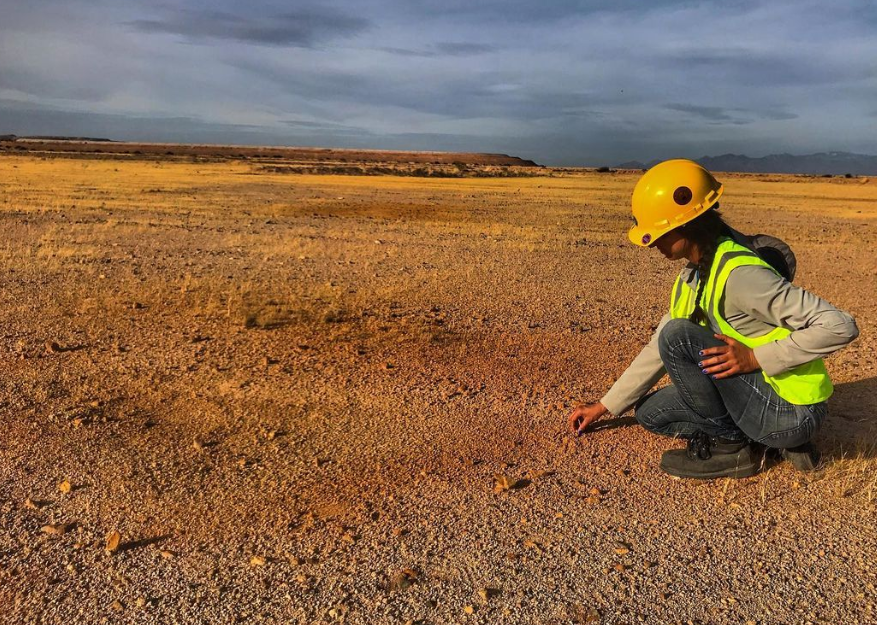Field sampling at an Arizona mining site
Current Research Projects:
1) Understanding Methane gas emissions impact on the lumbee Nation’s health and sovereignty
Over the last decade, natural gas has become an increasingly important energy source in the United States. Methane (CH4) is the primary component of natural gas and is also a powerful greenhouse gas. In this project, we seek to better understand ecologically how natural gas pipelines are impacting rural landscapes within the present day territory of the Lumbee Nation.
2) Evaluating the Biotic Potential of Degraded Soil Development on Reclaimed Mine Tailings in Southern Arizona
This research project is out of the Center for Environmentally Sustainable Mining and the Lowell Institute for Mineral Resources.
2) Tribal Governance Authority of Mineral Extraction on Public Lands: Rosemont Mine as a Case Study
This research project relates to my University of Arizona minor in American Indian Studies.
3) Indigenous Data Sovereignty: How Environmental Researchers Can Empower Indigenous Data Governance
This research is in conjunction with the Collaboratory of Indigenous Data Governance and the Native Nations Institute at the University of Arizona.
4) INDIGENOUS food knowledges network (IFKN)
IFKN is a research network comprised of Indigenous leaders, community practitioners, and scholars (both Indigenous and non-Indigenous) who are focused on research and community capacity related to food sovereignty and Indigenous Knowledge. I am a member of the Steering Committee.
Check out a recent lecture we did with the Norton School of Consumer Sciences, on “ Putting Indigenous Data Sovereignty into Practice: The Indigenous Food Knoweldges Network.”
Research experience
Climate adaptation planning to support ecosystems and people in the Gila River Watershed, Arizona
Sept 2019-March 2021.
A project funded by: Southwest Climate Adaptation Science Center Natural Resources Workforce Development Fellowship Program.
The report also details projected future values of monthly mean precipitation for the basin with resulting spring river flows are projected to decrease dramatically, by 37% of historical values, near the end of the 21st century. We found no significant trend in annual flow volume, but variability from year-to-year is projected to increase. Overall, our investigation suggests that stakeholders within the river basins are united by concerns related to water quantity, interest in management-based solutions, and a willingness to collaborate, even with some concerns of competing goals and strategies. Despite this high willingness to collaborate (98% of respondents), collaborative efforts between stakeholders were common (69%) but were not distributed equally across the basin. This is most notable in a lack of collaborations between Tribal and non-Tribal communities. The Gila River Indian Community (GRIC) located along the Gila River has a robust climate adaptation plan, suggesting that outside organizations can benefit from collaboration with GRIC and other Tribes.
Read final report here.
Graduate Research Assistant-Environmental Microbiology Group in the Department of Environmental Science.
University of Arizona
January 2014 - December 2020
Advisor: Dr. Raina Maier
Developing microbial biogeochemical indicators as tools to evaluate active mine reclamation with the Center for Environmentally Sustainable Mining.
Researching polices around extraction on federal land that tribal Nations have ancestral rights claims.
Indigenous Data Sovereignty & Data Governance for Environmental Scientists.
Environmental Toxicologist, Department of Environmental Toxicology.
University of california, davis-Granite canyon Marine pollution studies laboratory.
September 2011- December 2013
Advisor: Brian Anderson, MS
Projects included:
Stream Pollution Trends Project- Collected and preformed toxicity tests on samples from 97 watersheds throughout California to determine water quality trends, spatial and temporal variability, and optimized sediment toxicity testing system. I also preformed data entry and created GIS visuals for annual reports.
Assessment of Hypersaline Brine to Seven Marine Species-Preformed nine Ocean Plan toxicity tests using a concentration gradient of hyper saline brine in order to determine the effect of salinity on survival, growth, development and fertilization processes of seven common marine organisms. Information was used to inform regulatory agencies about the potential biological effects of a planned desalinization project.
The San Francisco Bay Regional Monitoring Program- Preformed toxicity testing on sediment samples in collaboration with the San Francisco Estuary Institute to monitor the San Francisco Bay ecosystem.
The Effectiveness of Vegetative Treatment Systems on Agricultural Runoff- Collected and preformed toxicity tests on agriculture run-off samples that were treated by a vegetative system in order to evaluate the effectiveness of off-farm pesticide loads. Helped maintain the weirs and plant growth in the system.
Undergraduate researcher
california state UNIVERSITY, monterey bay.
seaside, ca
Advisor: Sharon Anderson, Ph.D.
Developed a six-month monitoring project in collaboration with the Monterey National Marine Sanctuary Network to collect and analyze surface street sediment for heavy metal pollution in watershed areas within the Monterey Peninsula.
Performed trace metals analysis using an inductively coupled plasma mass spectrometry.
Undergraduate researcher
university of southern california
los angeles, ca
Advisor: Sergio Sañudo Wilhelmy, Ph.D.
Evaluated nutrients and trace metals influence B-vitamin synthesis and cycling in pelagic waters using high performance liquid chromatography detection and multivariate statistical analysis.
Undergraduate researcher
georgia institute of technology
atlanta, ga.
2009-Chemical Aquatic Ecology Research Experience for Undergraduates.
Advisor: Joseph Montoya, Ph.D.
Completed nutrient analysis and nitrogen fixation measurements using gas chromatography on the cyanobacteria Trichodesmium.
Undergraduate researcher
University of California, Santa Cruz
Santa cruz, ca
2008-ACCESS Summer Research Experience for Undergraduates
Advisor: A. Russell Flegal, Ph.D.
Evaluated submarine groundwater discharge for methylmercury.
Assisted in field sampling, nutrient analysis, suspended sediment analysis, and total mercury analysis.
Undergraduate researcher
National marine and fisheries services-Southwest fisheries science center
Santa cruz, ca
2006
Advisor: Susan Sogard, Ph.D.
Conducted fecundity analysis of larval partition on rockfish species to understand maternal effects on larval quality in rockfish.
Aided in electro shock fishing of juvenile steelhead salmon.
Presenting at the 2019 American Geophysical Union National Conference on my work with establishing biologicall metrics for mining reclamation in arid ecosystems. Picture credit: Dr. Laura Meredith.


